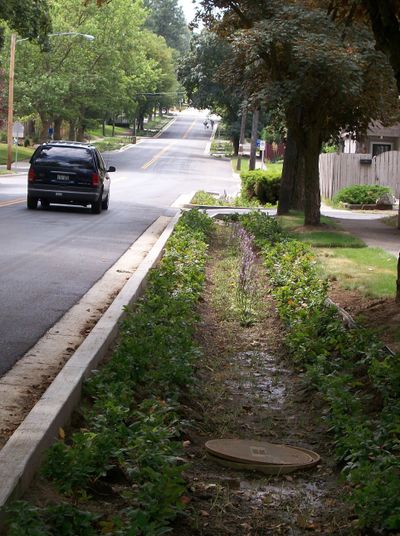Vestal: Smooth streets well worth turmoil of construction

What does it say about driving in Spokane that cruising on the new Lincoln Street on the South Hill is such a ridiculous pleasure?
No bouncing, no jouncing, no squeaking struts.
Well, it’s a pretty nice stretch of road, for one thing, what with the new “storm gardens” to catch rainwater and all. But if so many other roads weren’t crumbling messes, it’s hard to imagine that mere flat asphalt would be such a joy.
So I’m here today to sing the praises of construction disruption. With roads torn up all over town, it’s worth remembering that the short-term headaches are not only worth it, but long overdue.
“Nobody likes to go into the hospital for knee surgery or anything like that,” said Joe Tortorelli, executive director of the Spokane Area Good Roads Association. “But after it’s done, you’re so thankful.”
Spokane has been getting a lot of new knees these past few years. And yet we’re not even close to taking care of all our creaky joints. If we want to stop battering our suspension systems, we’re going to have to figure out a way to keep going – and that way, of course, is going to cost money.
Spokane’s current roadwork comes largely thanks to a $117 million road bond passed by voters in 2004 – which addressed a list of roadwork that can charitably be called overdue. Pressing the bond issue was one of the late Mayor Jim West’s big achievements – he promised to fix the streets during the campaign, helped drive efforts to put it on the ballot quickly, and led a process that developed a plan that appealed to voters just two years after they’d torpedoed a smaller bond package.
Even so, that bond – probably the biggest street-fixing success story in the city’s recent history – was good for about half the backlog of roadwork.
And that was six years ago.
The old stretch of Lincoln between 17th and 29th avenues, to pick just one example, was a crumbling nightmare until earlier this year. The city’s director of engineering services, Mike Taylor, likened it to Beirut earlier this year in a newspaper story, and the annual patching and half-measures had done nothing to address the fundamental problem deep below the road’s surface. This year, city workers rebuilt the road from the underground up.
Second Avenue downtown is undergoing a similar “rehabilitation.” If you drive downtown, this is old news – getting around is a serious pain. The work has dragged on for weeks and is likely to stretch into November. I know that some folks are getting pretty tired of it, and I can understand that.
What I’m getting tired of are all the unfixed roads. Too many spots in this city remind you of driving on a backcountry washboard. The Second Avenue project will fix long-term surface problems, as well as replace some water pipes. It’s part of a package of downtown projects, including the resurfacing of Madison, Adams and Jefferson streets.
I’m thinking it will be worth the hassle.
The city is spending about $60 million in street bond funding on 40 projects this summer – about the same as last year, said city streets spokeswoman Ann Deasy. So far, we’re a little more than halfway through the projects voters approved in 2004.
So that’s good. But if all you ever do is catch up on the stuff that’s long overdue, you never really catch up. Elected officials and transportation advocates are trying to identify some ways to cover road work consistently, rather than trying to squeeze it from the general funds.
The city is likely to put another road bond before voters in the next few years, Deasy said. An effort like the current one – with a well-defined list of specific projects – could be another winner.
Meanwhile, an effort by transportation advocates and elected officials is under way to create a permanent source of road funding for the region. Tortorelli and his group, among others, are pushing for the creation of a countywide “transportation benefit district.” The district would have the ability to levy a fee on top of license plate tabs, with voter approval.
Tortorelli realizes that now is no time to be asking voters for additional money. But he said if the county created such a district, it would make it possible to do so when times improve.
In a perfect world, keeping up with road maintenance in the city and county would cost some $40 million a year, Tortorelli said. Which isn’t going to happen.
Covering half that amount would require a $45 license tab fee. A $20 fee would raise more than $8 million a year.
Maybe it’s just the recession talking, but I have a hard time imagining those fees succeeding at the ballot box. Maybe, as Tortorelli hopes, they’ll seem more palatable when the economy improves.
I’m not sure. Here in Crumbletown, we’re a lot better at complaining than we are at footing the bill. What we need to do is get just a little addicted to smooth driving. Get to the point where one flat patch of road isn’t such a wild anomaly.
Maybe driving on Lincoln – or, eventually, on Second or Northwest Boulevard – will be like a gateway drug.
At first, we’ll be able to take it or leave it. Eventually, we won’t be able to live without it.